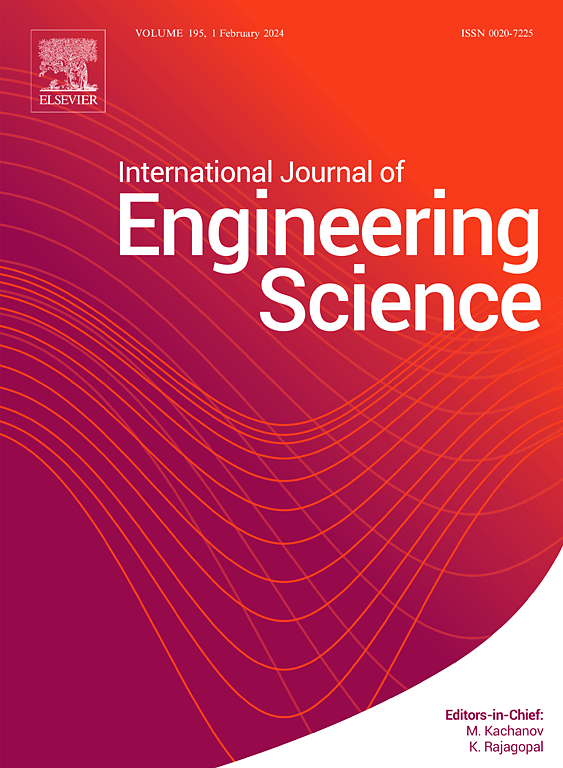俯仰振荡下容器内非线性液体晃动等几何边界元分析
IF 5.7
1区 工程技术
Q1 ENGINEERING, MULTIDISCIPLINARY
International Journal of Engineering Science
Pub Date : 2025-08-20
DOI:10.1016/j.ijengsci.2025.104371
引用次数: 0
摘要
本文提出了一种求解振动激励下矩形容器内非线性液体晃动问题的等几何边界元法(IGABEM)。基于半拉格朗日方法,定义了一个固定的全局坐标系和一个与容器同步运动的局部笛卡尔坐标系。从拉普拉斯方程出发,利用高斯散度定理和分部积分法,结合自由曲面的非线性运动和动力边界条件,导出了液体晃动问题的边界积分方程。然后建立相应的边界元解体系。采用非均匀有理b样条(NURBS)作为形状函数,精确描述几何边界,逼近未知的物理场。该方法最终得到了振动容器中非线性液体晃动问题的离散方程。与传统的多项式插值形状函数相比,NURBS提供了更好的单元内和跨单元接口的连续性以及局部支持。这些特性使它们特别适合满足液体表面的连续性要求。对于时间积分,采用二阶龙格-库塔算法进行时间步进,求解IGABEM系统方程,在每个时间步长计算变量梯度,实时更新计算网格。给出了一系列的数值算例,并将结果与解析解、实验数据和可选的数值方法进行了比较,分析了自由和强制液体晃动、自由表面波动和内压。这些比较验证了所提方法的准确性和鲁棒性。数值算例进一步研究了外部激励频率、激励幅值、旋转中心位置和底部障碍物高度对矩形容器内液体晃动响应的影响。结果表明,激振频率、旋转中心垂直偏心率和障碍物高度的变化对液体晃动行为有显著影响。本文章由计算机程序翻译,如有差异,请以英文原文为准。
Isogeometric boundary element analysis of nonlinear liquid sloshing in containers under pitching oscillation
This paper proposes an isogeometric boundary element method (IGABEM) to solve the nonlinear liquid sloshing problem in a rectangular container subjected to oscillatory excitation. Based on the semi-Lagrange approach, a fixed global coordinate system and a local Cartesian coordinate system that moves synchronously with the container are defined. Starting from the Laplace equation, the boundary integral equations for the liquid sloshing problem are derived using Gauss’s divergence theorem and the integration by parts technique, while incorporating nonlinear kinematic and dynamic boundary conditions of the free surface. The corresponding boundary element solution system is then formulated. Non-Uniform Rational B-Splines (NURBS) are employed as shape functions to accurately describe the geometric boundaries and approximate the unknown physical fields. This method ultimately produces the discrete equations governing nonlinear liquid sloshing problem in an oscillating container. Compared with traditional polynomial interpolation shape functions, NURBS provide improved continuity both within elements and across element interfaces as well as local support. These properties make them particularly suitable for satisfying the continuity requirements of the liquid surface. For time integration, a second-order Runge–Kutta algorithm is employed for time-stepping to solve the IGABEM system equations, compute variable gradients at each time step, and update the computational grid in real-time. A series of numerical examples are presented, the results are compared with analytical solutions, experimental data, and alternative numerical methods for free and forced liquid sloshing, free surface fluctuations and internal pressures. These comparisons validate the accuracy and robustness of the proposed method. The numerical examples further investigate the effects of external excitation frequency, excitation amplitude, rotation center position, and bottom obstacle height on liquid sloshing responses in the rectangular container. The results indicate that changes in excitation frequency, vertical eccentricity of the rotation center, and obstacle height significantly influence the liquid sloshing behavior.
求助全文
通过发布文献求助,成功后即可免费获取论文全文。
去求助
来源期刊

International Journal of Engineering Science
工程技术-工程:综合
CiteScore
11.80
自引率
16.70%
发文量
86
审稿时长
45 days
期刊介绍:
The International Journal of Engineering Science is not limited to a specific aspect of science and engineering but is instead devoted to a wide range of subfields in the engineering sciences. While it encourages a broad spectrum of contribution in the engineering sciences, its core interest lies in issues concerning material modeling and response. Articles of interdisciplinary nature are particularly welcome.
The primary goal of the new editors is to maintain high quality of publications. There will be a commitment to expediting the time taken for the publication of the papers. The articles that are sent for reviews will have names of the authors deleted with a view towards enhancing the objectivity and fairness of the review process.
Articles that are devoted to the purely mathematical aspects without a discussion of the physical implications of the results or the consideration of specific examples are discouraged. Articles concerning material science should not be limited merely to a description and recording of observations but should contain theoretical or quantitative discussion of the results.
 求助内容:
求助内容: 应助结果提醒方式:
应助结果提醒方式:


